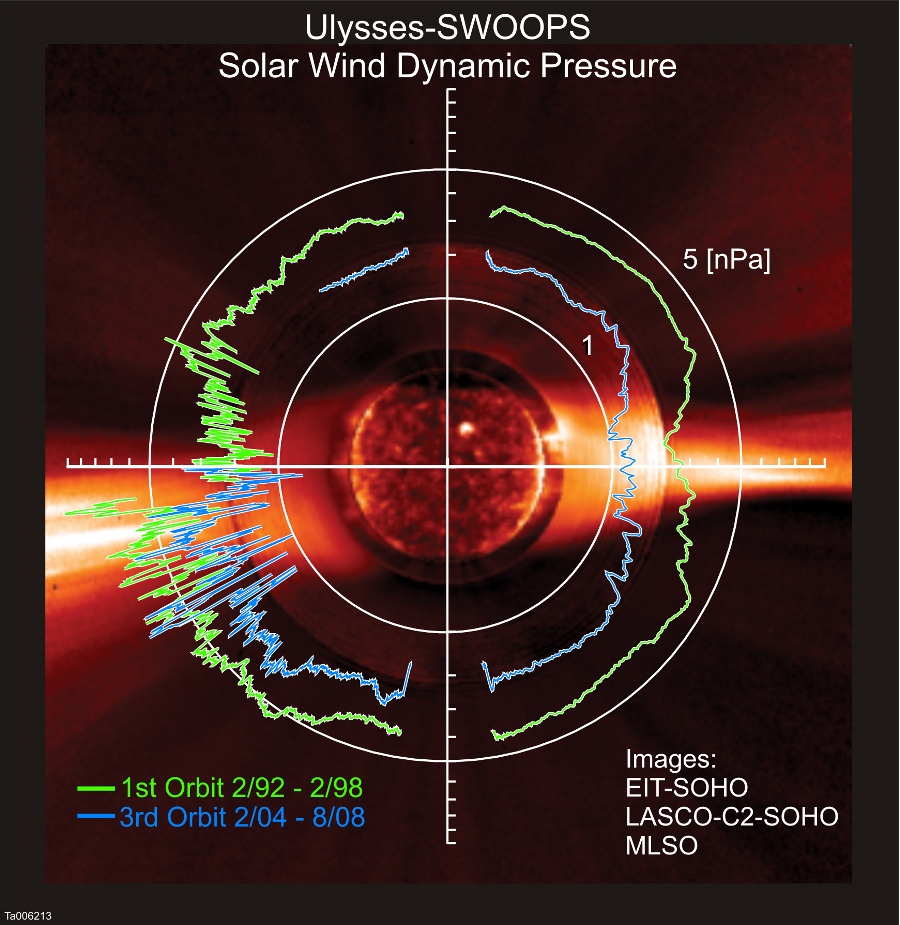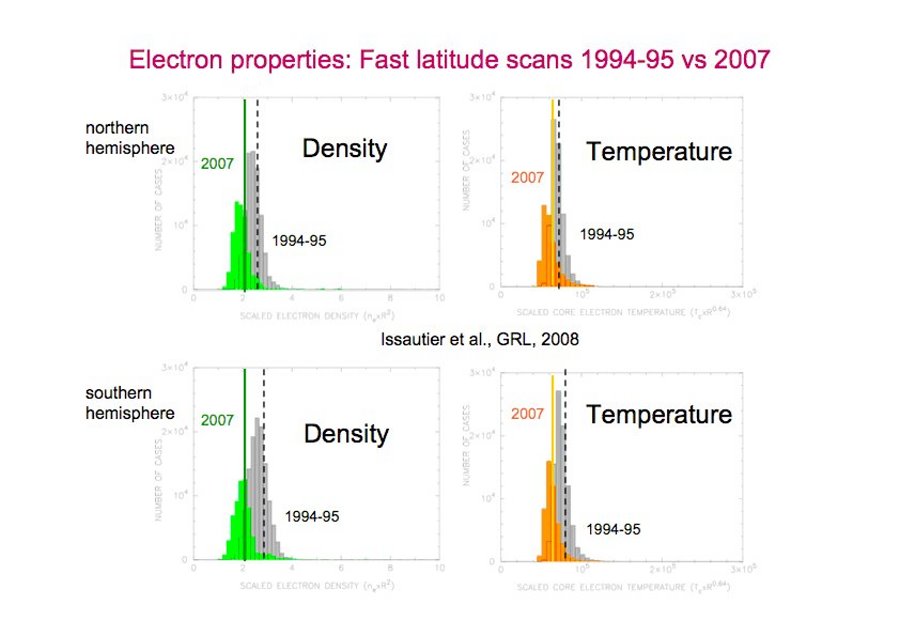|
|
|||
|
..
while blue curves denote lower pressure winds in 2004-2008. [Larger image] Solar Wind Loses Power, Hits 50-year Low + Play Audio | + Download Audio Sept. 23, 2008 In a briefing today at NASA headquarters, solar physicists announced that the solar wind is losing power. "The average pressure of the solar wind has dropped more than 20% since the mid-1990s," says Dave McComas of the Southwest Research Institute in San Antonio, Texas. "This is the weakest it's been since we began monitoring solar wind almost 50 years ago." McComas is principal investigator for the SWOOPS solar wind sensor onboard the Ulysses spacecraft, which measured the decrease. Ulysses, launched in 1990, circles the sun in a unique orbit that carries it over both the sun's poles and equator, giving Ulysses a global view of solar wind activity: Above Curiously, the speed of the million mph solar wind hasn't decreased much—only 3%. The change in pressure comes mainly from reductions in temperature and density. The solar wind is 13% cooler and 20% less dense. "What we're seeing is a long term trend, a steady decrease in pressure that began sometime in the mid-1990s," explains Arik Posner, NASA's Ulysses Program Scientist in Washington DC. How unusual is this event? "It's hard to say. We've only been monitoring solar wind since the early years of the Space Age—from the early 60s to the present," says Posner. "Over that period of time, it's unique. How the event stands out over centuries or millennia, however, is anybody's guess. We don't have data going back that far." Flagging solar wind has repercussions across the entire solar system—beginning with the heliosphere.
The heliosphere is a bubble of magnetism springing from the sun and inflated to colossal proportions by the solar wind. Every planet from Mercury to Pluto and beyond is inside it. The heliosphere is our solar system's first line of defense against galactic cosmic rays. High-energy particles from black holes and supernovas try to enter the solar system, but most are deflected by the heliosphere's magnetic fields. "The solar wind isn't inflating the heliosphere as much as it used to," says McComas. "That means less shielding against cosmic rays." In addition to weakened solar wind, "Ulysses also finds that the sun's underlying magnetic field has weakened by more than 30% since the mid-1990s," says Posner. "This reduces natural shielding even more." Unpublished Ulysses cosmic ray data show that, indeed, high energy (GeV) electrons, a minor but telltale component of cosmic rays around Earth, have jumped in number by about 20%. These extra particles pose no threat to people on Earth's surface. Our thick atmosphere and planetary magnetic field provide additional layers of protection that keep us safe. But any extra cosmic rays can have consequences. If the trend continues, astronauts on the Moon or en route to Mars would get a higher dose of space radiation. Robotic space probes and satellites in high Earth orbit face an increased risk of instrument malfunctions and reboots due to cosmic ray strikes. Also, there are controversial studies linking cosmic ray fluxes to cloudiness and climate change on Earth. That link may be tested in the years ahead.
according to measurements made by the Ulysses spacecraft. Some of most dramatic effects of the phenomenon may be felt by NASA's two Voyager spacecraft. After traveling outward for 30+ years, the two probes are now at the edge of the heliosphere. With the heliosphere shrinking, the Voyagers may soon find themselves on the outside looking in, thrust into interstellar space long before anyone expected. No spacecraft has ever been outside the heliosphere before and no one knows what the Voyagers may find there. NASA is about to launch a new spacecraft named IBEX (short for Interstellar Boundary Explorer) that can monitor the dimensions of the heliosphere without actually traveling to the edge of the solar system. IBEX may actually be able to "see" the heliosphere shrinking and anticipate the Voyager's exit. Moreover, IBEX will reveal how our solar system's cosmic ray shield reacts to changes in solar wind. "The potential for discovery," says McComas, "is breathtaking." Author:
Dr. Tony Phillips
Related Links:
|
|||
| FAIR USE NOTICE: This page contains copyrighted material the use of which has not been specifically authorized by the copyright owner. Pegasus Research Consortium distributes this material without profit to those who have expressed a prior interest in receiving the included information for research and educational purposes. We believe this constitutes a fair use of any such copyrighted material as provided for in 17 U.S.C § 107. If you wish to use copyrighted material from this site for purposes of your own that go beyond fair use, you must obtain permission from the copyright owner. | |||
|
|



